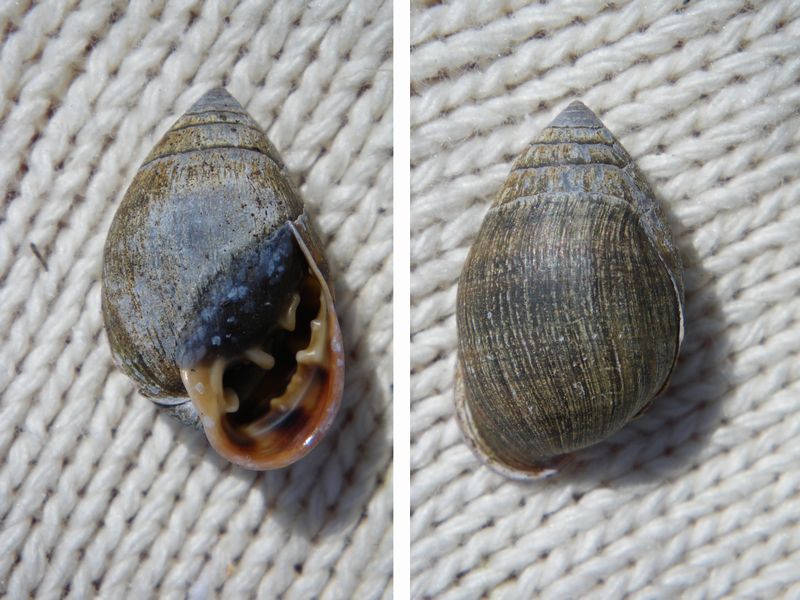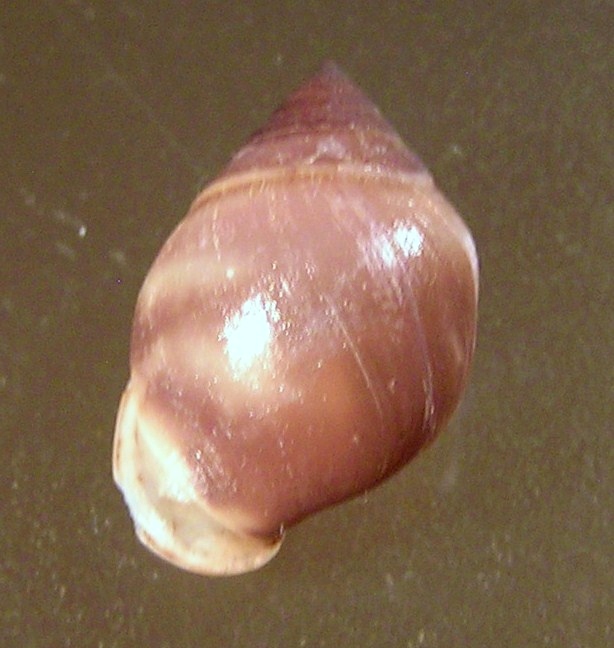|
Pythia Cecillii
''Pythia cecillii'' is a species of small air-breathing salt marsh snail, a pulmonate gastropod mollusk in the family Ellobiidae. MolluscaBase eds. (2022). MolluscaBase. Pythia cecillii (Philippi, 1847). Accessed through: World Register of Marine Species at: https://www.marinespecies.org/aphia.php?p=taxdetails&id=1468332 on 2022-03-21 The specific name ''cecillii'' is in honor of the French admiral Jean-Baptiste Cécille Jean-Baptiste Thomas Médée Cécille (16 October 1787, Rouen – 9 November 1873) was a French Admiral and politician who played an important role in the French intervention of Vietnam. He also circumnavigated the globe. Military career In .... Distribution This species occurs in Japan. It is critically endangered and endangered (CR+EN) in Japan.. accessed 1 October 2009 References External links Philippi, R. A. (1847-1848). Testaceorum novorum centuria. Zeitschrift für Malakozoologie. 4(5): 71-77; 4(6): 84-96; 4(8): 113-127 Ellobiidae G ... [...More Info...] [...Related Items...] OR: [Wikipedia] [Google] [Baidu] |
Animal
Animals are multicellular, eukaryotic organisms in the Kingdom (biology), biological kingdom Animalia. With few exceptions, animals Heterotroph, consume organic material, Cellular respiration#Aerobic respiration, breathe oxygen, are Motility, able to move, can Sexual reproduction, reproduce sexually, and go through an ontogenetic stage in which their body consists of a hollow sphere of Cell (biology), cells, the blastula, during Embryogenesis, embryonic development. Over 1.5 million Extant taxon, living animal species have been Species description, described—of which around 1 million are Insecta, insects—but it has been estimated there are over 7 million animal species in total. Animals range in length from to . They have Ecology, complex interactions with each other and their environments, forming intricate food webs. The scientific study of animals is known as zoology. Most living animal species are in Bilateria, a clade whose members have a Symmetry in biology#Bilate ... [...More Info...] [...Related Items...] OR: [Wikipedia] [Google] [Baidu] |
Rodolfo Armando Philippi
Rodolfo Amando (or Rudolph Amandus) Philippi (14 September 1808 – 23 July 1904) was a German–Chilean paleontologist and zoologist. Philippi contributed primarily to malacology and paleontology. His grandson, Rodulfo Amando Philippi Bañados (1905-1969), was also a zoologist and in order to avoid confusion in zoological nomenclature, the elder is referred to as "Philippi rumwiede to distinguish him from his grandson "Philippi añados. Early life Philippi was born in Charlottenburg, Berlin to Johann Wilhelm Eberhard Philippi, a Prussian government auditor, and his third wife Maria Anna Krumwiede (m. 1806). The father had five children from two earlier marriages and Philippi was the eldest from the third marriage. In 1818, Philippi, his younger brother Bernhard Eunom (1811–1852) and their mother went to Yverdon-les-Bains, Switzerland, where they were educated at the Pestalozzian Institute founded by Johann Heinrich Pestalozzi (1746–1827). The teaching included the use o ... [...More Info...] [...Related Items...] OR: [Wikipedia] [Google] [Baidu] |
Mollusk
Mollusca is the second-largest phylum of invertebrate animals after the Arthropoda, the members of which are known as molluscs or mollusks (). Around 85,000 extant species of molluscs are recognized. The number of fossil species is estimated between 60,000 and 100,000 additional species. The proportion of undescribed species is very high. Many taxa remain poorly studied. Molluscs are the largest marine phylum, comprising about 23% of all the named marine organisms. Numerous molluscs also live in freshwater and terrestrial habitats. They are highly diverse, not just in size and anatomical structure, but also in behaviour and habitat. The phylum is typically divided into 7 or 8 taxonomic classes, of which two are entirely extinct. Cephalopod molluscs, such as squid, cuttlefish, and octopuses, are among the most neurologically advanced of all invertebrates—and either the giant squid or the colossal squid is the largest known invertebrate species. The gas ... [...More Info...] [...Related Items...] OR: [Wikipedia] [Google] [Baidu] |
Gastropod
The gastropods (), commonly known as snails and slugs, belong to a large taxonomic class of invertebrates within the phylum Mollusca called Gastropoda (). This class comprises snails and slugs from saltwater, from freshwater, and from land. There are many thousands of species of sea snails and slugs, as well as freshwater snails, freshwater limpets, and land snails and slugs. The class Gastropoda contains a vast total of named species, second only to the insects in overall number. The fossil history of this class goes back to the Late Cambrian. , 721 families of gastropods are known, of which 245 are extinct and appear only in the fossil record, while 476 are currently extant with or without a fossil record. Gastropoda (previously known as univalves and sometimes spelled "Gasteropoda") are a major part of the phylum Mollusca, and are the most highly diversified class in the phylum, with 65,000 to 80,000 living snail and slug species. The anatomy, behavior, feeding, and re ... [...More Info...] [...Related Items...] OR: [Wikipedia] [Google] [Baidu] |
Pulmonate
Pulmonata or pulmonates, is an informal group (previously an order, and before that a subclass) of snails and slugs characterized by the ability to breathe air, by virtue of having a pallial lung instead of a gill, or gills. The group includes many land and freshwater families, and several marine families. The taxon Pulmonata as traditionally defined was found to be polyphyletic in a molecular study per Jörger ''et al.'', dating from 2010. Pulmonata are known from the Carboniferous Period to the present. Pulmonates have a single atrium and kidney, and a concentrated, symmetrical, nervous system. The mantle cavity is located on the right side of the body, and lacks gills, instead being converted into a vascularised lung. Most species have a shell, but no operculum, although the group does also include several shell-less slugs. Pulmonates are hermaphroditic, and some groups possess love darts. Linnean taxonomy The taxonomy of this group according to the taxonomy of the Ga ... [...More Info...] [...Related Items...] OR: [Wikipedia] [Google] [Baidu] |
Snail
A snail is, in loose terms, a shelled gastropod. The name is most often applied to land snails, terrestrial pulmonate gastropod molluscs. However, the common name ''snail'' is also used for most of the members of the molluscan class Gastropoda that have a coiled shell that is large enough for the animal to retract completely into. When the word "snail" is used in this most general sense, it includes not just land snails but also numerous species of sea snails and freshwater snails. Gastropods that naturally lack a shell, or have only an internal shell, are mostly called '' slugs'', and land snails that have only a very small shell (that they cannot retract into) are often called ''semi-slugs''. Snails have considerable human relevance, including as food items, as pests, and as vectors of disease, and their shells are used as decorative objects and are incorporated into jewelry. The snail has also had some cultural significance, tending to be associated with lethargy. The sn ... [...More Info...] [...Related Items...] OR: [Wikipedia] [Google] [Baidu] |
Salt Marsh
A salt marsh or saltmarsh, also known as a coastal salt marsh or a tidal marsh, is a coastal ecosystem in the upper coastal intertidal zone between land and open saltwater or brackish water that is regularly flooded by the tides. It is dominated by dense stands of salt-tolerant plants such as herbs, grasses, or low shrubs. These plants are terrestrial in origin and are essential to the stability of the salt marsh in trapping and binding sediments. Salt marshes play a large role in the aquatic food web and the delivery of nutrients to coastal waters. They also support terrestrial animals and provide coastal protection. Salt marshes have historically been endangered by poorly implemented coastal management practices, with land reclaimed for human uses or polluted by upstream agriculture or other industrial coastal uses. Additionally, sea level rise caused by climate change is endangering other marshes, through erosion and submersion of otherwise tidal marshes. However, recent ackn ... [...More Info...] [...Related Items...] OR: [Wikipedia] [Google] [Baidu] |
Species
In biology, a species is the basic unit of classification and a taxonomic rank of an organism, as well as a unit of biodiversity. A species is often defined as the largest group of organisms in which any two individuals of the appropriate sexes or mating types can produce fertile offspring, typically by sexual reproduction. Other ways of defining species include their karyotype, DNA sequence, morphology, behaviour or ecological niche. In addition, paleontologists use the concept of the chronospecies since fossil reproduction cannot be examined. The most recent rigorous estimate for the total number of species of eukaryotes is between 8 and 8.7 million. However, only about 14% of these had been described by 2011. All species (except viruses) are given a two-part name, a "binomial". The first part of a binomial is the genus to which the species belongs. The second part is called the specific name or the specific epithet (in botanical nomenclature, also sometimes i ... [...More Info...] [...Related Items...] OR: [Wikipedia] [Google] [Baidu] |
Pythia (gastropod)
''Pythia'' is a genus of small air-breathing salt marsh snails, pulmonate gastropod mollusks in the subfamily Pythiinae of the family Ellobiidae.Bouchet, P. (2011). Pythia Röding, 1798. Accessed through: World Register of Marine Species at http://www.marinespecies.org/aphia.php?p=taxdetails&id=560065 on 2011-12-04 ''Pythia'' is a largely terrestrial genus commonly found in the Indo-Pacific. It lives in mangroves from above high tide to further inland. It is readily differentiated within the family by its dorso-ventrally flattened shell and heavily dentate aperture. Plate gave the first account of ''Pythia scarabaeus'' in 1897. ''Pythia'' is the type genus of the subfamily Pythiinae. Species According to the World Register of Marine Species, species in the genus ''Pythia'' include: * '' Pythia albovaricosa'' L. Pfeiffer, 1853 * '' Pythia anhi'' Thach, 2016 * '' Pythia apiensis'' E. A. Smith, 1884 * '' Pythia bischofi'' I. Rensch, 1937 * † '' Pythia bonneti'' (Cossmann, 1895) ... [...More Info...] [...Related Items...] OR: [Wikipedia] [Google] [Baidu] |
Mollusca
Mollusca is the second-largest phylum of invertebrate animals after the Arthropoda, the members of which are known as molluscs or mollusks (). Around 85,000 extant species of molluscs are recognized. The number of fossil species is estimated between 60,000 and 100,000 additional species. The proportion of undescribed species is very high. Many taxa remain poorly studied. Molluscs are the largest marine phylum, comprising about 23% of all the named marine organisms. Numerous molluscs also live in freshwater and terrestrial habitats. They are highly diverse, not just in size and anatomical structure, but also in behaviour and habitat. The phylum is typically divided into 7 or 8 taxonomic classes, of which two are entirely extinct. Cephalopod molluscs, such as squid, cuttlefish, and octopuses, are among the most neurologically advanced of all invertebrates—and either the giant squid or the colossal squid is the largest known invertebrate species. The gastropod ... [...More Info...] [...Related Items...] OR: [Wikipedia] [Google] [Baidu] |








